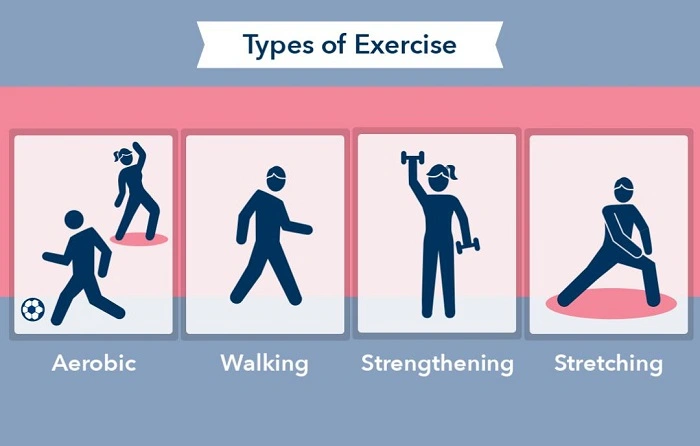Introduction to Types of Exercise: Choosing the Right Workout for Your Health
Exercise plays a crucial role in maintaining and improving overall health, fitness, and well-being. However, not all exercises are the same—there are various types that target different aspects of physical fitness. Understanding the different types of exercise allows you to create a balanced fitness routine tailored to your personal goals, whether it’s weight loss, muscle building, endurance, flexibility, or balance improvement. In this article, we will explore the main categories of exercise, their benefits, and how to incorporate them into your daily life for maximum results.
Cardiovascular Exercise: The Heart and Lung Booster

Cardiovascular exercise, often referred to as aerobic exercise, focuses on increasing your heart rate and breathing for sustained periods. It is essential for improving cardiovascular health, burning calories, and enhancing endurance.
Popular Cardiovascular Exercises
- Running or jogging
- Brisk walking
- Cycling
- Swimming
- Dancing and aerobics classes
Benefits of Cardiovascular Exercise
Engaging in regular cardiovascular workouts helps improve heart and lung function, increases stamina, aids in weight management, and reduces the risk of chronic diseases like diabetes, hypertension, and stroke. Cardiovascular exercise also releases endorphins, improving mood and reducing stress.
How to Incorporate Cardiovascular Exercise
Aim for at least 150 minutes of moderate-intensity or 75 minutes of vigorous-intensity aerobic activity per week. This can be broken down into 30-minute sessions, five times a week. For beginners, starting with walking or cycling and gradually increasing intensity is recommended.
Strength Training: Building Muscle and Enhancing Metabolism
Strength training involves exercises designed to increase muscle strength and mass by working against resistance. This type of exercise is vital for maintaining muscle tone, improving metabolism, and supporting joint health.
Common Strength Training Activities
- Weightlifting (free weights and machines)
- Bodyweight exercises (push-ups, squats, lunges, planks)
- Resistance band workouts
- Functional training (using kettlebells, medicine balls)
Benefits of Strength Training
Besides increasing muscle mass, strength training boosts resting metabolic rate, helps prevent osteoporosis by strengthening bones, improves posture, enhances balance, and reduces the risk of injury. It also supports better glucose metabolism, benefiting individuals with or at risk of diabetes.
How to Start Strength Training
For beginners, bodyweight exercises are an excellent start. Incorporate strength training exercises at least two to three times per week, allowing rest days between sessions for muscle recovery. Using proper form is crucial, so consider working with a fitness professional initially.
Flexibility Exercises: Enhancing Range of Motion and Preventing Injuries
Flexibility exercises are focused on stretching muscles and tendons to increase the range of motion in joints. This type of training is often overlooked but is essential for maintaining mobility and preventing injuries.
Common Flexibility Exercises
- Static stretching (holding stretches for 15-60 seconds)
- Dynamic stretching (moving stretches like leg swings)
- Yoga
- Pilates
- Tai Chi
Benefits of Flexibility Training
Improved flexibility helps reduce muscle stiffness and soreness, enhances posture, increases blood flow to muscles, and improves physical performance. Additionally, flexibility exercises contribute to relaxation and stress reduction.
Tips for Flexibility Workouts
Incorporate flexibility exercises into your routine daily or at least 3-4 times weekly. Warm up muscles with light activity before stretching to prevent injury. Avoid bouncing during static stretches to minimize muscle strain.
Balance Exercises: Stability for Life and Sport
Balance exercises help improve your body’s ability to maintain stability and coordination, which is especially important as we age but beneficial for all ages.
Popular Balance Exercises
- Standing on one leg
- Heel-to-toe walk
- Stability ball exercises
- Using balance boards or Bosu balls
- Tai Chi and yoga poses focusing on balance
Benefits of Balance Training
Better balance reduces the risk of falls and injuries, improves athletic performance, enhances core strength, and supports daily activities such as walking and climbing stairs. It also helps in maintaining independence in older adults.
How to Practice Balance Training
Integrate balance exercises into your routine at least two to three times weekly. Start with simple movements like standing on one leg and progress to more challenging exercises as your balance improves.
High-Intensity Interval Training (HIIT): Efficient and Powerful Fitness

HIIT is a training technique involving repeated bursts of high-intensity effort followed by varied recovery times. It combines cardiovascular and strength components and is popular for its efficiency.
Examples of HIIT Workouts
- Sprint intervals alternating with walking or jogging
- Circuit training with bodyweight exercises
- Tabata training (20 seconds of work, 10 seconds rest)
- Cycling or rowing sprints
Benefits of HIIT
HIIT improves cardiovascular fitness, increases fat burning during and after exercise (the afterburn effect), enhances metabolic rate, and improves insulin sensitivity. It’s ideal for people with limited time, offering maximum results in shorter sessions.
Incorporating HIIT Safely
Due to its intensity, HIIT should be done 2-3 times per week with at least one rest or low-intensity day between sessions. Beginners should start with moderate intervals and gradually increase intensity.
Combining Different Types of Exercise for Optimal Health
A well-rounded fitness program includes cardiovascular, strength, flexibility, and balance exercises. This combination ensures comprehensive physical development and reduces the risk of overuse injuries.
Weekly Exercise Recommendations
- Cardiovascular: 150 minutes moderate or 75 minutes vigorous intensity
- Strength training: 2-3 sessions per week
- Flexibility: 3-5 sessions per week, preferably daily stretching
- Balance: 2-3 times per week, especially for older adults
Creating a Balanced Routine
Example weekly schedule:
- Monday: Cardio + strength training
- Tuesday: Flexibility + balance exercises
- Wednesday: HIIT or cardio
- Thursday: Strength training + flexibility
- Friday: Cardio or active recovery (walking, yoga)
- Weekend: Rest or light activity focusing on flexibility and balance
Additional Exercise Types to Consider
Functional Training
Focuses on movements that improve daily activities by enhancing strength, balance, and coordination.
Mind-Body Exercises
Such as yoga, Pilates, and Tai Chi, which promote physical fitness along with mental well-being.
Recreational Activities
Sports like tennis, swimming, hiking, and dancing, which combine exercise with enjoyment and social interaction.
FAQs About Types of Exercise
What is the best type of exercise for beginners?
Starting with moderate cardiovascular activities like walking combined with basic strength and flexibility exercises is ideal for beginners.
How often should I do strength training?
At least two non-consecutive days per week focusing on all major muscle groups.
Can I lose weight with flexibility exercises alone?
Flexibility exercises improve mobility but don’t significantly contribute to weight loss without cardiovascular or strength training.
Is it necessary to do balance exercises if I’m young?
While critical for older adults, balance training benefits all ages by improving coordination and injury prevention.
How soon can I see results from exercising?
Physical and mental benefits often appear within a few weeks, but visible changes in body composition may take 6-8 weeks of consistent exercise.
Embrace Variety for Long-Term Fitness Success
Incorporating a variety of exercise types into your routine enhances overall fitness, reduces injury risks, and keeps your workouts engaging. Whether your goal is improving heart health, building strength, increasing flexibility, or enhancing balance, a balanced approach ensures comprehensive benefits and lasting results. Begin with manageable steps, stay consistent, and listen to your body for a healthier, stronger you.








